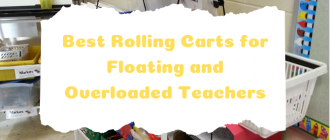
Gardening, in general, is considered a healthy occupation for children. It relieves stress, builds confidence, and has a positive impact on psychological wellbeing. These observations are the results of studies conducted all over the world.
Also…
Growing plants also encourages planning, initiative, and organizational skills. If you have a greenhouse at your school, that’s even better. I have one, which is how I got started. It allows me to plant fast-growing seeds for the classroom at any time of year.
I made the science class even more interesting by asking the children to measure their plants every day, decide if it needs shade or sunlight, and monitor the amount of water they need.
Unfortunately, not all children have the opportunity to participate in gardening. They may not have a yard, an adult to encourage them, or some other limitation. Since my school has a gardening room, we can plant all year round.
I knew all my kids could have the chance to plant seeds, take care of them, and watch them develop into full-blown plants.
Flowering Plants For Kids To Grow
| Product | Details | ||
|---|---|---|---|
| 1. French Marigold |  Best Pest Control |
Edible
|
Check Current Price |
| 2. Sunflower |  Best For Pollination |
Provides Seeds For Birds
|
Check Current Price |
| 3. Simpson Lettuce |  Best Foliage |
Primary Heirloom Variety
|
Check Current Price |
Here are a few of the most popular that you can get:
1.Nasturtium
Nasturtiums are brightly-colored, edible plants that are very easy to grow and usually bloom the whole summer. You may wonder why I mention that they’re edible.
When young children are involved, there’s always the chance they may decide to taste a seed. After all, they regularly eat sunflower seeds, popcorn, and sesame seeds, so why not try some others? That’s is the main reason I avoid Morning Glory and Foxglove.
Note: Morning Glory seeds are poisonous, and Foxglove seeds are toxic. However, they’re fast-growing. If your students are old enough to understand that they’re poisonous, and shouldn’t be tasted, you can use them.
Nasturtiums produce vibrant warm colors that make a great show when they bloom. They’re considered companion plants, and provide pest control in a vegetable garden, which is a good way to introduce organic farming.
2. Cosmos
Cosmos produce a very satisfying blossom. It resembles the type of flower most children draw and comes in a variety of colors. Some even have two colors. They have a straight stem that shoots straight up, with the blossom at the top. They grow quickly and bloom profusely throughout the summer. You can buy packages that contain a variety of colors. These flowers make great bouquets.
3. Marigolds
Marigolds are another fast-growing edible plant that comes in brilliant yellow, red or gold colors. They don’t grow as tall as cosmos, but they also produce a satisfying blossom. These plants need full sun exposure and are often planted among vegetables for natural pest control. People don’t like the fragrance very much, and neither do insects.
4. Sunflowers
Sunflowers are hugely popular with children because they grow tall and provide more seeds for birds and squirrels during the winter.
The seeds may also be collected and sown again the following spring. My students, who chose to grow sunflowers, measure them every day to see how much they grew and who had the tallest.
5. Zinnias
California Giant Zinnias are easy to grow and last all summer and well into the fall. They attract birds and bees and some grow to over three feet tall. They require full sun and come in a variety of warm colors. These are a favorite with my children because of the huge, colorful blossoms.
More To Grow
Flower blossoms are gorgeous, especially for a child who has started it from a seed, but there are other fast-growing seeds they can plant as part of classroom activity.
1. Grass
Grass is fast-growing and is a great plant for the classroom. As was mentioned in the first video, the pot can be painted to look like a person, animal, or cartoon character.
When the grass grows, it resembles hair standing straight up. This is hilarious for most kids, and the added bonus is that they can trim it into funny hairstyles with scissors, and it’ll grow back.
2. Black-Seeded Simpson Lettuce
Some kids may not be too excited about eating lettuce, but it’s very exciting to grow. The reason is that it produces a lot of foliage. Once the shoots start to sprout, it looks like you’ve planted a mini forest.
3. Beans
Beans and peas are common choices for science activities. They germinate in seven to 10 days and grow to produce edible results. Bean shoots are sturdy and easier for children to handle than the more delicate pea shoots, but they’re both good options for this activity.
What You Need For Planting Seeds
To grow seeds, you also need some simple supplies.
Crystal Clear PET Plastic Cups
These crystal-clear PET plastic cups are safe for children. They have no sharp edges and are heavy-duty. Children can handle them, drop them, and squeeze them. and they bounce back. These are also good for planting seeds in wet paper towels, so it’s easy to watch the seed germinate. You’ll need to poke a hole in the bottom for drainage.
Hefty Party On Disposable Plastic Cups

These strong plastic cups come in four colors which make it easy to identify the type of seed that was planted. For example, you can use one color for nasturtiums and a different color for beans.
With four colors, you can have a good variety of plants, and it makes labeling easier. These cups are strong, so if you have some children that plan to transplant their plant into a pot or garden, you can ask them to bring back the cup and use it again the next year. You’ll need to poke a hole in the bottom for drainage.
KINGLAKE Plastic Plants Nursery Pot
Instead of plastic cups, you can also use plastic pots. Kids love these because they look like “real” pots. They’re designed for germinating seeds and are reusable. These are the pots I use for seed planting in my classroom. I like them because they’re ready to use with eight small drain holes.
KINGLAKE Pots Planter
These colorful pots are the most durable and the most expensive. They’re ready to go off the shelf with pre-drilled drainage holes. The colors are useful for identification.
Each child can have a particular color, or the colors can be used to identify the type of seed. They’re made of thick, reusable plastic that won’t crack when placed in direct sunlight for several seasons.
One nice thing about these is that they’re attractive enough to be part of the presentation. If your children plan to grow flowers as a gift for their mothers, these pots look great. Each package contains eight pots, so you may need several packages for your class.
Bootstrap Farmer 1020 Trays
This is a professional-grade, recyclable plastic tray for seed starting. It’s very durable and BPA-free. The tray has no holes, so once the seed germinates, it’ll need to be transplanted into a cup or pot with drainage holes on the bottom.
It’s useful for heat mats, microgreens, humidity domes, fodder, and wheatgrass. With a 10-pack, you can get two, five, or 10 with clear plastic domes that make a mini-greenhouse.
Burpee Premium Organic Potting Mix
This is a high-quality planting mix, but it’s worth the price because it virtually guarantees your seeds will grow. It’s suitable for containers and gardens. The coconut coir helps the mix retain moisture so the seedlings will last a day or two without being watered.
Some Other Seeds For Classroom Science Activities
Pumpkins and Squash: These large and easy-to-handle seeds germinate in six to 10 days.
Radishes: Radish seeds easily absorb water and push up a shoot relatively quickly. For some children, radish seeds are hard to handle because they’re very small. The shoots are also small and don’t produce very dramatic results, but the final, bright red radish is satisfying.
Watermelon: The seeds are large and easy to handle, and the shoot appears in five to 10 days. Honeydew and cantaloupe are also good melons to plant.
Helpful Tip
If you’re concerned about time but would like to let your kids grow some seeds, there’s one way to can speed up germination.
Since the seed needs to soak up water before it starts germinating, you can scratch the seed gently on sandpaper. This is called scarification and helps make water absorption quicker. Then, you soak the seed overnight in warm water. The next day, you give the seeds to your class.
Sample Projects That I think Are Great
- The first one is by an incredibly enthusiastic teacher who sees the value of fun learning activities, no matter the weather or time of year. She wants to encourage you to keep up the momentum in your classroom towards the end of the year when you and your kids may feel like winding down. Planting fast-growing seeds is a lot of fun, and she offers several ideas that increase the benefit. These include grass which looks like hair that needs to be trimmed, and flowers to take home to Mom for Mother’s Day. After she explains the setting, you see the children participate in the planting and caring for the seeds. The flower pots are also part of the activity. Each child paints or decorates a pot for his or her plant. This is done the day before planting so the paint has time to dry.
- This video gives an example of how growing seeds can be a multi-disciplinary activity. It teaches the scientific method with a writing component that asks the children to think. They need to take notice of what the seed looks like now, and predict how it’ll look when it starts sprouting. The activity also includes plans for the future, and even starting a garden in their school. You’ll see in the video how this activity is great for every child. Whether they immediately grasp the science aspect or not, they can enjoy caring for and watching their plants grow.
- This video shows the benefit of using a clear container for the seeds. By using wet paper towels instead of soil, the children can actually see the seed germinate and start to put out tiny roots and stems. They use trimmed water bottles, which also teach recycling and avoiding single-use plastic. Each container is made into a “monster” with eyes and a nose glued on the side. When the grass grows, it looks like monster hair, and the kids love to trim it and watch it grow back.
Which Flowers To Grow
While grass is fun and keeps on being fun after children take their monsters home (because they need to regularly trim the hair), flowers are the most satisfying plant.
It provides a tangible expression of the child’s work and care. It also makes a great present, which is why one teacher planned an activity so that the class could take home a flower for Mother’s Day.
You may wonder what the definition of “fast-growing” is. Flower seeds that germinate in less than 14 days and produce a blossom within 70 days are considered fast-growing.
All the above videos show the beginning activities, from choosing the pot, filling it with soil, and planting the seed. It’s great fun, and children love it, but then what? They have to wait forever (it seems) to get any action.
How To Plant Seeds In The Classroom
Before starting on your journey from seed to blossom, it may help your students to see this video:
Fun And Easy Activity Guide
Here’s a step-by-step guide that will help make the activity fun and easy.
Materials
- A pot for each child – You can choose from the ones I recommended above, or cut about four inches off the bottom of two-liter plastic water bottles and poke small holes in the bottom.
- Soil – I recommend you use potting soil such as the high-quality one mentioned above. Bringing in soil from outside could bring some unwanted elements such as waste material, insects, and worms.
- Seeds – I recommend you give your students a choice of seeds. Some may love to grow flowers, but others may be more interested in growing food. If they’re happy about what they’re growing, they’ll pay closer attention to all aspects of the science lesson.
- Craft sticks or ice cream sticks – These are used for labeling. The name of the plant is written on one side of the stick, and it’s pushed into the soil. The name of the child who planted the seed can be written on the other side if the children plan to keep track of their own plant. There’s just one problem with this method of labeling: the sticks can be switched, and there may be a jokester who loves to do it, or it could happen by accident. That’s why I label the pot.
- Small trowel or large spoon – This is for scooping the soil into the pots.
- Spray bottle with water – This lets the children water the seeds and shoots gently by simulating rain. Heavy watering can kill the seed or knock over a sprout.
Steps
- Start by labeling or decorating the pot. As mentioned above, for growing grass, we made the pots look like monster heads and the grass became the hair. Attractive colored pots or pots that look like ceramic garden pots may not need to be decorated. The child’s name and the type of plant can be written on the pot. Be sure to use a permanent marker so it doesn’t wash off.
- Before you open the seed packets, show the children the picture on the front. They can see how their plant will look and choose the one they like. After they open the packet, they can compare the seeds to see how different they look. A bean seed may be much larger than a flower seed.
- Empty the bag of soil into a bin with a wide mouth so the children can easily scoop it out. They shouldn’t fill their pots to the top because there needs to be room for water. One way is to count out loud the number of scoops needed for each pot. Put at least three seeds in each pot. This is to ensure that at least one will germinate. My children hold the seeds in one hand and plant them in the pot with the other. They can push the seeds down into the soil and cover them, or put a little more soil on top.
- After explaining that the seeds need water, as seen in the video they saw before, give them the spray bottle to water each plant. The trays with the pots can be taken to a window to get enough sunlight.
Useful Information
Some people love to garden and know a lot about planting flowers and/or vegetables and caring for them. Others have no interest in digging in the soil, but still like to see beautiful bouquets of flowers and eat tasty veggies.
Whether you have a good grasp of seed germination or not, you may want to use seed planting as a great science project for your class.
I recommend you read these instructions to learn about (or freshen up on) the different stages of plant growth and the rudiments of planting. Created by Purdue University, it’s a guide for home gardening for annual plants. The site tells you all about growing annual flowers, so you can give your students the information they need to understand the science of germination and what type of blossom to expect from the type of seed they’ve chosen.
Another website offers an extensive database created by Cornell University on different plants. There, you can learn more about the seeds you’ve selected. Each flower has a profile that gives a detailed description of the plant, plus growing instructions, including soil requirements and the types of areas where the plant will flourish. Here’s a sample of one of the flowers I recommended above.
The Bottom Line
Planting seeds, caring for them, and watching them grow is a fascinating activity for early primary children. Fast-growing seeds for the classroom are the best choice for this activity because the kids don’t have to wait very long to see results.
There are many factors that influence seed germination and growth, so it’s a real multidisciplinary activity. Meanwhile, they develop patience, get a connection to the Earth, feel a sense of responsibility, and learn the science of plants.
I hope I’ve made it easier for you to find out whether or not you have a green thumb.
Last Updated on July 25, 2022 by Emily
- Facebook14
- Twitter21
- Pinterest67
- 102shares









![[100 Pack - 16 oz.] Crystal Clear PET Plastic Cups [100 Pack - 16 oz.] Crystal Clear PET Plastic Cups](https://m.media-amazon.com/images/I/41xrIJkLi0L._SL500_.jpg)








Hi Emily! I read your blog all the time and have gotten so many good ideas that save me time and make me a better teacher. One thing I am having trouble with is allowing each child to plant a seed and watch it grow. The activity is fun and easy to do but it seems every time we do it one or two seeds don’t grow and there are a few disappointed children. They refuse to start over because their classmates all have growing plants and they don’t. I have taken special care with each plant to make sure it is properly planted and watered with the right amount of sunlight but I can’t escape at least one if not two failures every time. Please give me some ideas about how to handle this.
Hi Susan! It’s always gratifying to hear from readers that they are benefiting from my research and ideas. True, seeds can be tricky, but there is a simple solution. The only catch is it needs to be done secretly. You can buy seeds that are guaranteed to sprout, but, still, you never know. It may take a little effort but if it saves a child from feeling dejected, it’s worth it. Make a second batch of planted seeds that looks and is labeled just like the original. You will know a few days in advance if one of the seeds isn’t going to sprout and you can exchange it with the other one without anyone knowing. While this isn’t a guarantee, it will give your class a better chance that everyone is pleased and satisfied.